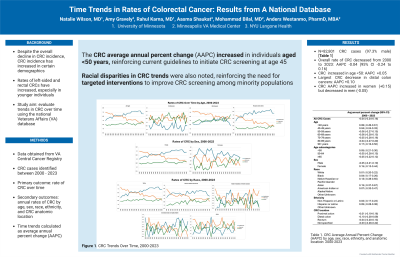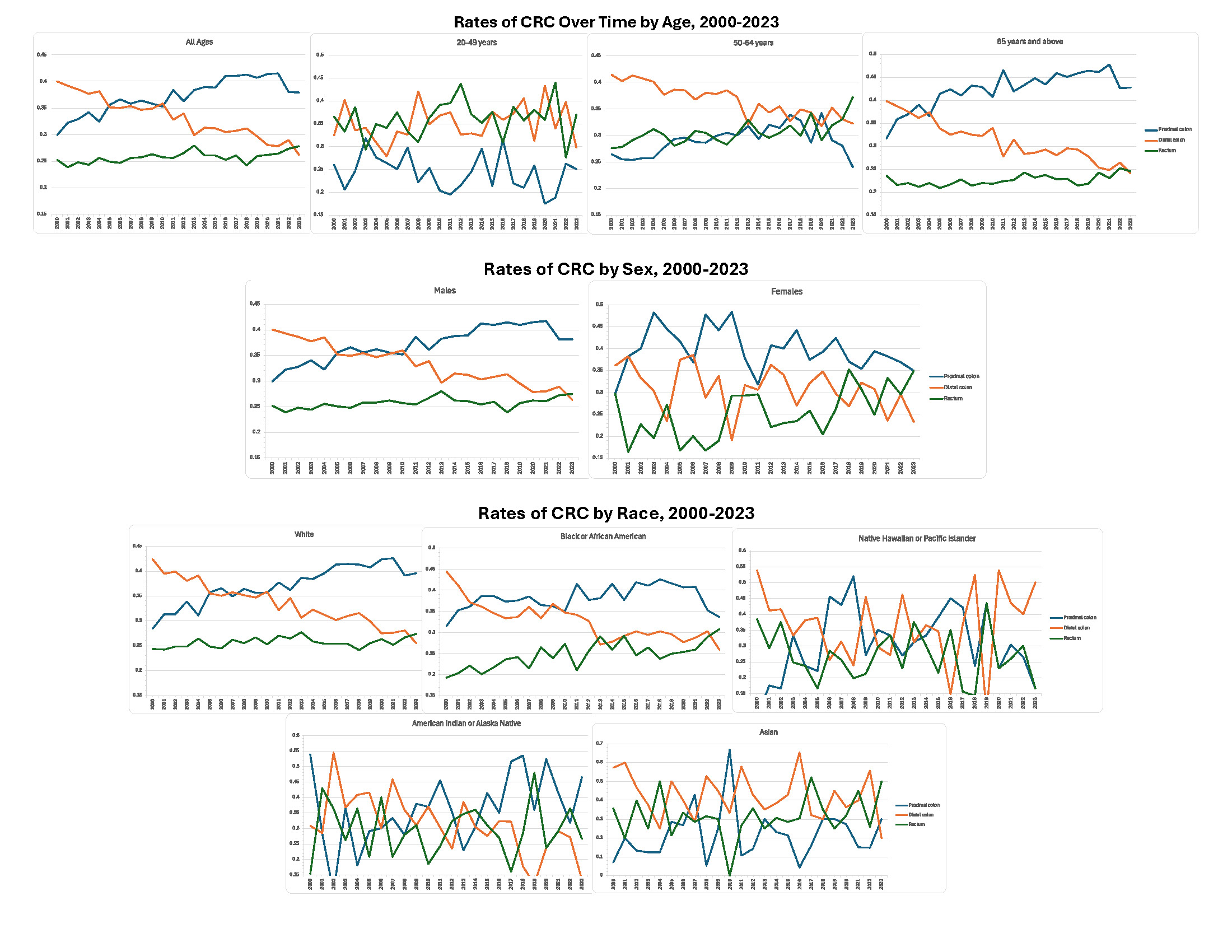Monday Poster Session
Category: Colon
P1957 - Time Trends in Rates of Colorectal Cancer: Results From a National Database
Monday, October 28, 2024
10:30 AM - 4:00 PM ET
Location: Exhibit Hall E


Natalie Wilson, MD
University of Minnesota
Minneapolis, MN
Presenting Author(s)
Natalie Wilson, MD1, Amy Gravely, MA2, Rahul Karna, MD3, Aasma Shaukat, MD, MPH4, Mohammad Bilal, MD5, Anders Westanmo, PharmD, MBA2
1University of Minnesota, Minneapolis, MN; 2Minneapolis VA Health Care System, Minneapolis, MN; 3University of Minnesota Medical Center, Minneapolis, MN; 4NYU Langone Health, New York, NY; 5University of Minnesota and Minneapolis VA Health Care System, Minneapolis, MN
Introduction: Despite the overall decline in colorectal cancer (CRC) incidence over the past decade, CRC incidence has increased in certain demographic groups, particularly those under age 50. Additionally, there has been a rise in left-sided and rectal CRCs across all age groups, though the trend has been most notable in younger individuals. The aim of this study is to evaluate trends in rates of CRC over time using a national database.
Methods: Data was obtained from the Veterans Affairs (VA) Central Cancer Registry (VACCR). The VACCR is a national registry that receives and stores data on cancer diagnosis and treatment across each of the 132 VA medical centers dating back to 1995.
Data was obtained for CRC cases between 2000 to 2023. The primary outcome was rate of CRC over time. Secondary outcomes were annual rates of CRC stratified by age, sex, race, ethnicity, and CRC location. Time trends were calculated as average annual percent change (AAPC).
Results: A total of 82,801 cases of CRC were reported (97.3% male) [Table 1]. The overall rate of CRC decreased from 2000 to 2023 (AAPC -0.04; 95% CI [-0.24-0.16]). When stratified by CRC location, the largest decrease was seen in distal colon cancers (descending and sigmoid) with AAPC 0.10 (95% CI [-0.28-0.09]) followed by rectum (AAPC -0.04; 95% CI [-0.20-0.13]) and proximal colon (cecum, ascending, transverse) with AAPC -0.01 (95% CI [-0.19-0.16]) [Figure 1]. The AAPC decreased among men (-0.05; 95% CI [0.21-0.10]) and increased among women (0.15; 95% CI [-0.13-0.44]). Across age groups, AAPC increased in those younger than 50 years (0.05; 95% CI [-0.21-0.30]) and decreased in all other age groups except 90 years and older (0.17; 95% CI [-0.16-0.50]). While the AAPC increased across all races, the highest increases were seen in Asian race (0.15; 95% CI [-0.37-0.67]), Native Hawaiian or Pacific Islander (0.13; 95% CI [-0.38-0.65]), and American Indian or Alaska Native (0.07; 95% CI [-0.33-0.47)].
Discussion: Our study shows an increase in the rates of CRC in individuals < 50 years old, which reinforces current gastroenterology society guidelines to initiate CRC screening at age 45 years. Additionally, our study found significant racial disparities in CRC trends, reinforcing the need for targeted interventions to enhance CRC screening among minority populations.

Note: The table for this abstract can be viewed in the ePoster Gallery section of the ACG 2024 ePoster Site or in The American Journal of Gastroenterology's abstract supplement issue, both of which will be available starting October 27, 2024.
Disclosures:
Natalie Wilson, MD1, Amy Gravely, MA2, Rahul Karna, MD3, Aasma Shaukat, MD, MPH4, Mohammad Bilal, MD5, Anders Westanmo, PharmD, MBA2. P1957 - Time Trends in Rates of Colorectal Cancer: Results From a National Database, ACG 2024 Annual Scientific Meeting Abstracts. Philadelphia, PA: American College of Gastroenterology.
1University of Minnesota, Minneapolis, MN; 2Minneapolis VA Health Care System, Minneapolis, MN; 3University of Minnesota Medical Center, Minneapolis, MN; 4NYU Langone Health, New York, NY; 5University of Minnesota and Minneapolis VA Health Care System, Minneapolis, MN
Introduction: Despite the overall decline in colorectal cancer (CRC) incidence over the past decade, CRC incidence has increased in certain demographic groups, particularly those under age 50. Additionally, there has been a rise in left-sided and rectal CRCs across all age groups, though the trend has been most notable in younger individuals. The aim of this study is to evaluate trends in rates of CRC over time using a national database.
Methods: Data was obtained from the Veterans Affairs (VA) Central Cancer Registry (VACCR). The VACCR is a national registry that receives and stores data on cancer diagnosis and treatment across each of the 132 VA medical centers dating back to 1995.
Data was obtained for CRC cases between 2000 to 2023. The primary outcome was rate of CRC over time. Secondary outcomes were annual rates of CRC stratified by age, sex, race, ethnicity, and CRC location. Time trends were calculated as average annual percent change (AAPC).
Results: A total of 82,801 cases of CRC were reported (97.3% male) [Table 1]. The overall rate of CRC decreased from 2000 to 2023 (AAPC -0.04; 95% CI [-0.24-0.16]). When stratified by CRC location, the largest decrease was seen in distal colon cancers (descending and sigmoid) with AAPC 0.10 (95% CI [-0.28-0.09]) followed by rectum (AAPC -0.04; 95% CI [-0.20-0.13]) and proximal colon (cecum, ascending, transverse) with AAPC -0.01 (95% CI [-0.19-0.16]) [Figure 1]. The AAPC decreased among men (-0.05; 95% CI [0.21-0.10]) and increased among women (0.15; 95% CI [-0.13-0.44]). Across age groups, AAPC increased in those younger than 50 years (0.05; 95% CI [-0.21-0.30]) and decreased in all other age groups except 90 years and older (0.17; 95% CI [-0.16-0.50]). While the AAPC increased across all races, the highest increases were seen in Asian race (0.15; 95% CI [-0.37-0.67]), Native Hawaiian or Pacific Islander (0.13; 95% CI [-0.38-0.65]), and American Indian or Alaska Native (0.07; 95% CI [-0.33-0.47)].
Discussion: Our study shows an increase in the rates of CRC in individuals < 50 years old, which reinforces current gastroenterology society guidelines to initiate CRC screening at age 45 years. Additionally, our study found significant racial disparities in CRC trends, reinforcing the need for targeted interventions to enhance CRC screening among minority populations.

Figure: Figure 1. Rates of CRC Over Time, 2000-2023
Note: The table for this abstract can be viewed in the ePoster Gallery section of the ACG 2024 ePoster Site or in The American Journal of Gastroenterology's abstract supplement issue, both of which will be available starting October 27, 2024.
Disclosures:
Natalie Wilson indicated no relevant financial relationships.
Amy Gravely indicated no relevant financial relationships.
Rahul Karna indicated no relevant financial relationships.
Aasma Shaukat: iterative health; Freenome – Consultant.
Mohammad Bilal: Boston Scientific – Consultant. Cook endoscopy – Speakers Bureau.
Anders Westanmo indicated no relevant financial relationships.
Natalie Wilson, MD1, Amy Gravely, MA2, Rahul Karna, MD3, Aasma Shaukat, MD, MPH4, Mohammad Bilal, MD5, Anders Westanmo, PharmD, MBA2. P1957 - Time Trends in Rates of Colorectal Cancer: Results From a National Database, ACG 2024 Annual Scientific Meeting Abstracts. Philadelphia, PA: American College of Gastroenterology.
